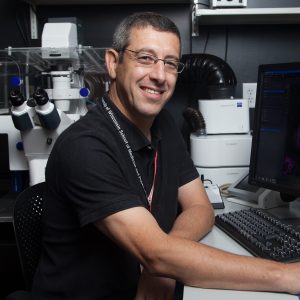
B.Sc., Life Sciences, Ben-Gurion University of the Negev, Israel
M.Sc., Medical Biochemistry, The Hebrew University of Jerusalem, Israel
Ph.D., Genetics, The Hebrew University of Jerusalem
Postdoctoral Research, Stem Cell and Regenerative Biology, Harvard University
- Islet architecture in adult mice is actively maintained by Robo2 expression in β cells
- Disrupted glucose homeostasis and glucagon and insulin secretion defects in Robo βKO mice
- Axon Guidance Molecules in the Islets of Langerhans
- Determinants and dynamics of pancreatic islet architecture
- The Anna Karenina Model of β-Cell Maturation in Development and Their Dedifferentiation in Type 1 and Type 2 Diabetes
- Reduced synchroneity of intra-islet Ca<sup>2+</sup> oscillations in vivo in <em>Robo</em>-deficient β cells
- CDK2 limits the highly energetic secretory program of mature β cells by restricting PEP cycle-dependent K<sub>ATP</sub> channel closure
- Morphogenesis of the Islets of Langerhans Is Guided by Extraendocrine Slit2 and Slit3 Signals
- Endocrine cell type sorting and mature architecture in the islets of Langerhans require expression of Roundabout receptors in β cells
- Synaptotagmins Tweak Functional β Cell Maturation
- Angptl4 links α-cell proliferation following glucagon receptor inhibition with adipose tissue triglyceride metabolism
- Reversal of β cell de-differentiation by a small molecule inhibitor of the TGFβ pathway
- Functional beta-cell maturation is marked by an increased glucose threshold and by expression of urocortin 3
- The tumorigenicity of diploid and aneuploid human pluripotent stem cells
- Developmental programming of CpG island methylation profiles in the human genome
How does a newly formed stem or progenitor cell “know” it had reached its full differentiation capacity, and should assume its mature function? What part of the signal towards terminal differentiation comes from the cell’s interactions with its surrounding environment, and what is encoded in the blueprint of its intrinsic developmental program? How is this functionally mature state, once achieved, sustained throughout adult life, or tip off balance and erode in degenerative disease? And what exactly is a fully differentiated, functionally mature cell state? Not only do these questions represent fundamental problems in developmental biology, but they are also crucial in regenerative medicine, where one wants to impose a functionally mature phenotype upon stem cells differentiated in vitro, or prevent the loss of the mature cell state in degenerative diseases.
Our lab uses human pluripotent stem cells differentiation, developmental biology of the pancreas, mouse genetics, bioinformatics and functional genomic analyses to discover the genetic and molecular regulatory circuits controlling the development, maintenance, collapse and recovery of the fully differentiated, functionally mature β cell state in mice and humans.
Expanding our knowledge of functional β cell maturation will have an important impact on both stem cell based therapy for type-1 diabetes and on the prevention of irreversible β cell de-differentiation in type-2 diabetes. Specifically, it may lead to the ability to genetically set naive β cells differentiated from stem cells in vitro to produce and secrete exactly the right amount of insulin in response to a given concentration of glucose, as well as to prevent de-differentiation and maintain functional β cell maturation in diabetics.
Wisconsin Alumni Research Foundation Fall Competition Award
EMBO Long-Term Post-Doctoral Fellowship
JDRF Post-Doctoral Fellowship

